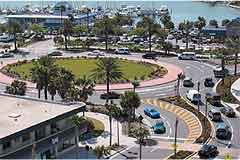Developed in the United Kingdom in the 1960s and built by the tens of thousands worldwide, roundabouts are just now catching on in the United States. About 1,000 have been built in recent years.

What's a roundabout? It's a circular intersection with design features promoting the safe and efficient flow of traffic. At modern roundabouts on US roads, vehicles go counterclockwise around a raised center island. Entering traffic yields to circulating traffic, negotiating an entry curve that's sharp enough to slow vehicles down to about 15 or 20 mph. These speeds are maintained by deflecting traffic around the relatively tight radius that characterizes a roundabout's center island.
What's different from old traffic circles? For starters, some of the older designs operated by the yield-to-right rule — circulating traffic yielded to entering vehicles. It's the opposite in a modern roundabout, which also is smaller and requires drivers to negotiate a sharper entry curve. This slows speeds more than in the older circles. Because of the higher speeds in the old designs, many of them had traffic signals to help reduce crashes. A benefit of most modern roundabouts is the absence of signals, so traffic slows but keeps moving.
What's the safety effect? Converting intersections from signal lights or stop signs to roundabouts reduces crashes (see Status Report, May 13, 2000; on the web at iihs.org). The biggest reductions are in crashes involving injuries. Right angle, left-turn, and head-on collisions are common at intersections with stop signs or lights, and they can be severe because the vehicles may be traveling through the intersections at high speeds. At roundabouts, such crashes essentially are eliminated because vehicles travel in the same direction. Roundabouts can reduce rear-end crashes, too, because there's no incentive for drivers to speed up as they approach or to stop abruptly.
Are there benefits besides safety? Yes. Roundabouts improve traffic flow because vehicles keep moving. This means emissions are reduced and fuel is conserved. One study found that replacing traffic signals with roundabouts reduced carbon monoxide, nitrous oxide, carbon dioxide, and hydrocarbon emissions. Another study estimated annual fuel savings of 200,000 gallons if 10 intersections in Virginia were converted to roundabouts. For answers to 14 questions about roundabouts, go to iihs.org/research.




